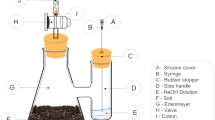Abstract
Degradation of the phenylurea herbicide isoproturon (3-(4-isopropylphenyl)-1,1-dimethylurea) and several phenylurea and aniline metabolites was studied in agricultural soils previously exposed to isoproturon. The potential for degradation of the demethylated metabolite 3-(4-isopropylphenyl)-1-methylurea in the soils was much higher compared to isoproturon. In the most active soil only 6% of added 14C-labelled isoproturon was mineralised to 14C2 within 20 days while in the same period 45% of added 14C-labelled 3-(4-isopropylphenyl)-1-methylurea was mineralized. This indicates that the initial N-demethylation may be a limiting step in the complete mineralization of isoproturon. Repeated addition of 3-(4-isopropylphenyl)-1-methylurea to the soil and further subculturing in mineral medium led to a highly enriched mixed bacterial culture with the ability to mineralize 3-(4-isopropylphenyl)-1-methylurea.The culture did not degrade either isoproturon or the didemethylatedmetabolite 3-(4-isopropylphenyl)-urea when provided as sole source of carbon and energy. The metabolite 4-isopropyl-aniline was also degraded and utilised for growth, thus indicating that 3-(4-isopropylphenyl)-1-methylurea is degraded byan initial cleavage of the methylurea-group followed by mineralizationof the phenyl-moiety. Several attempts were made to isolate pure bacterial cultures degrading 3-(4-isopropylphenyl)-1-methylurea or 4-isopropyl-aniline,but they were not successful.
Similar content being viewed by others
References
Alexander M (1994) Biodegradation and bioremediation. Academic Press, San Diego, California
Beck AJ,Harris GL,Howse KR,Johnston AE andJones KC (1996) Spatial and temporal variation of isoproturon residues and associated sorption/desorption parameters at the field scale. Chemosphere 33: 1283–1295
Berger BM (1998) Parameters influencing Biotransformation rates of phenylurea herbicides by soil microorganisms. Pestic. Biochem. Physiol. 60: 71–82
Cox L,Walker A &Welch SJ (1996) Evidence for the accelerated degradation of isoproturon in soils. Pestic. Sci. 48: 253–260
Cullington JE &Walker A (1999) Rapid biodegradation of diuron and other phenylurea herbicides by a soil bacterium. Soil Biol. Biochem. 31: 677–686
Engelhardt G,Wallnöfer PR &Plapp R (1973) Purification and properties of an aryl acylamidase of Bacillus Sphaericus, catalyzing the hydrolysis of various phenylamide herbicides and fungicides. Appl. Microbiol. 26: 709–718
Forlani G,Mangiagalli A, Nielsen E &Suardi CM (1999) Degradation of the phosphonate herbicide glyphosate in soil: evidence for a possible involvement of unculturable microorganisms. Soil Biol. Biochem. 31: 991–997
Gaillardon P &Sabar M (1994) Changes in the concentration of isoproturon and its degradation products in soil and soil solution during incubation at two temperatures. Weed Res. 34: 243–250
Hobbie JE,Dagley RJ &Jasper S (1977) Use of nucleopore filters for counting bacteria by fluorescence microscopy. Appl. Environ. Microbiol. 33: 1225–1228
Johnson AC,Hughes CD,Williams RJ &Chilton PJ (1998) Potential for aerobic isoproturon biodegradation and sorption in the unsaturated and saturated zones of a chalk aquifer. J. Contam. Hydrol. 30: 281–297
Juhler RK,Sørensen SR &Larsen L (2001) Analysing transformation products of herbicide residues in environmental samples. Water Res. 35: 17–24
Kristensen GB, Sørensen SR & Aamand J (accepted) Mineralization of 2,4-D, mecoprop, isoproturon, and terbuthylazine in a chalk aquifer. Pest Manag. Sci.
Kubiak R,Ellssel H,Lambert M &Eichhorn KW (1995) Degradation of isoproturon in soil in relation to changes of microbial biomass and activity in small-scale laboratory and outdoors studies. Intern. J. Environ. Anal. Chem. 59: 123–132
Kulshrestha G &Mukerjee SK (1986) The photochemical decomposition of the herbicide isoproturon. Pestic. Sci. 17: 489–494
Kulshrestha G (1983) Persistence of the herbicide isoproturon in soil. Asp. Appl. Biol. 4: 413–422
Larsen L,Sørensen SR &Aamand J (2000) Mecoprop, atrazine and isoproturon in a sandy aquifer: Vertical distribution of mineralization potential. Environ. Sci. Technol. 34: 2426–2430
Lehr S,Glässgen WE,Sandermann H,Beese Jr. F &Scheunert I (1996) Metabolism of isoproturon in soils originating from different agricultural management systems and in cultures of isolated bacteria. Intern. J. Environ. Anal. Chem. 65: 231–344
Mansour M,Feicht EA,Behechti A,Schramm KW &Kettrup A (1999) Determination photostability of selected agrochemicals in water and soil. Chemosphere 39: 575–585
Mudd PJ,Hance RJ &Wright SJL (1983) The persistence and metabolism of isoproturon in soil. Weed Res. 23: 239–347
Nitchke L &Schussler W (1998) Surface water pollution by herbicides from effluents of waste water treatment plants. Chemosphere 36: 35–41
Pieuchot M,Perrin-Ganier C,Portal J-M &Schiavon M (1996) Study on the mineralization and degradation of isoproturon in three soils. Chemosphere 33: 467–478
Remde A &Traunspurger W (1994) A method to assess the toxicity of pollutants on anaerobic microbial degradation activity in sediments. Environ. Toxicol. Wat. Qual. 9: 293–298
Reuter S,Ilim M,Munch JC,Andreux F &Scheunert I (1999) A model for the formation and degradation of bound residues of the herbicide 14C-isoproturon in soil. Chemosphere 39: 627–639
Ridgway HF,Safarik J,Phipps D,Carl P &Clark D (1990) Identi-fication and catabolic activity of well-derived gasoline-degrading bacteria from a contaminated aquifer. Appl. Environ. Microbiol. 56: 3565–3575
Roberts SJ,Walker A,Cox L &Welch SJ (1998) Isolation of isoproturon-degrading bacteria from treated soil via three different routes. J. App. Microbiol. 85: 309–316
Roberts SJ,Walker A,Parekh NR,Welch SJ &Waddington MJ (1993) Studies on a mixed bacterial culture from soil which degrades the herbicide linuron. Pestic. Sci. 39: 71–78
Schuelein J,Glaessgen WE,Hertkorn N,Schroeder P,Sandermann H Jr. &Kettrup A. (1996) Detection and identification of the herbicide isoproturon and its metabolites in field samples after a heavy rainfall event. Intern. J. Environ. Anal. Chem. 65: 193–202
Spliid HS &Køppen B (1998) Occurrence of pesticides in Danish shallow ground water. Chemosphere 37: 1307–1316
Torsvik V,Goksøyr J &Daae FL (1990) High diversity in DNA of soil bacteria. Appl. Environ. Microbiol. 56: 782–787
Walker A,Jurado-Exposito M,Bending GD andSmith VJR (2001) Spatial variability in the degradation rate of isoproturon in soil. Environ. Poll. 111: 407–415
Author information
Authors and Affiliations
Rights and permissions
About this article
Cite this article
Sørensen, S.R., Aamand, J. Biodegradation of the Phenylurea Herbicide Isoproturon and its Metabolites in Agricultural Soils. Biodegradation 12, 69–77 (2001). https://doi.org/10.1023/A:1011902012131
Issue Date:
DOI: https://doi.org/10.1023/A:1011902012131




